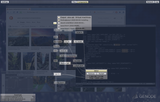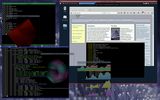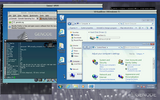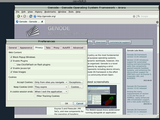Screenshots
Sculpt version 20.08 as released in September 2020. The central element of its novel administrative user interface is a live view of the running system that can be interactively modified. In the background, the current system composition shines through.
Sculpt as a Community Experience (CE) as released in March 2019. This version introduced an interactive user interface for connecting new components with system services and other components.
Desktop of Sculpt OS (TC). Firefox runs on TinyCore Linux inside a virtual machine. The Qt-based text editor allows the user to edit configurations - like the user-level network routing - live. On the top-right, the current CPU load is displayed. The terminal window below hosts the light-weight noux runtime environment for executing command-line-based Unix software.
The press of a button activates the "Leitzentrale" overlay, which empowers the user to inspect and change (sculpt) almost all aspects of the running system on the fly.
A Genode/NOVA-based desktop used for day-to-day computing at Genode Labs in 2015. VirtualBox runs Xubuntu, which is currently executing Genode's build system and Firefox. The command-line interface at the top left allows the user to manage Genode subsystems. At the bottom left, a noux instance acts as the bridge between the Linux guest OS and the Genode world. Under the surface, there are over 40 low-level components such as device drivers working together. Each of them is encapsulated in a dedicated sandbox.
VirtualBox running besides the Seoul VMM (virtual machine monitor) on top of Genode/NOVA. Seoul executes Tinycore Linux as guest OS. VirtualBox executes MS Windows 7. Both VMMs are utilizing hardware virtualization (VT-X) but are plain user-level programs with no special privileges.
Qt version 5.1 running natively on Genode 13.08.







